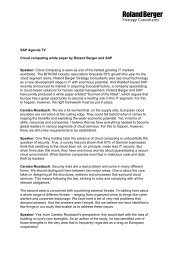The economics of IPTV - Roland Berger Strategy Consultants
The economics of IPTV - Roland Berger Strategy Consultants
The economics of IPTV - Roland Berger Strategy Consultants
- No tags were found...
You also want an ePaper? Increase the reach of your titles
YUMPU automatically turns print PDFs into web optimized ePapers that Google loves.
14InfoCom Competence CenterProper basic content <strong>of</strong>fer can increase customers'propensity to opt for value-adding buy-through packages.<strong>The</strong> basic package is usually presented as the minimumpackage the customer has to purchase in order to accessthe service. This ranges from must-carry TV to, in somemarkets, dozens <strong>of</strong> channels. It might be tempting toincrease the content <strong>of</strong> the basic package and thus justifyhigher basic pricing in an attempt to increase ARPU.However, to do so would create an entry barrier to thehigher value buy-through package for customers withnarrowly defined interests.Although the ideal composition <strong>of</strong> the basic package variesin accordance with viewers' interests, successful TV deploymentsgive viewers themselves the choice. Companies can<strong>of</strong>fer viewers a basic package consisting <strong>of</strong> must-carry andfree-to-air channels at a price perceived as being almostfree. In this way they create the lowest possible barriers tocustomers moving up to higher-value channels and makingbuy-through choices.<strong>The</strong> interests <strong>of</strong> content providers drive companies towardincluding as many channels as possible in the basic package.After all, every provider wants as large a distributionas possible. Additionally, providers with one successfulchannel may make its distribution conditional on theinclusion <strong>of</strong> their other channels in the basic package.This <strong>of</strong>ten expands the basic package and creates barriersto specialized or exclusive content. Viewers interested inmovies, for instance, have to purchase the basic packagejust to get access to the movie package. Should the basicpackage prove too costly, they may end up rejecting bothpackages.While exploring additional revenue streams such asadvertising and VoD, companies involved in <strong>IPTV</strong> shouldconstantly check that their live TV package structure reflectscustomer preferences. Allowing users to choose specializedor exclusive content t without t the entry barrier <strong>of</strong> an overloadedbasic package can significantly increase bothoverall <strong>IPTV</strong> and buy-through package penetration.3.1.2 Premium packagesIn the analyzed business model (see 3.1) premium packagesare designed as bundled <strong>of</strong>fers for premium users.<strong>The</strong>se packages usually <strong>of</strong>fer top-<strong>of</strong>-the-range content,functionality and options. This means exclusive content,HD versions, subscription Video on Demand, access toVideo on Demand, catch-up TV, network PVR and so on.This is where <strong>IPTV</strong> really comes into its own.Many features <strong>of</strong> premium packages have major costimplications, however. More expensive content, t costlierplatform licenses, higher network bandwidth requirements,more expensive STBs and residential gateways significantlyincrease the cost <strong>of</strong> premium packages. This can outweighthe superior revenue potential <strong>of</strong> premium packages.Figure 8 shows how subscription revenue contributes to thethree-year NPV variance. Premium penetration accounts forjust 0-5%, the increase in revenues being almost completely<strong>of</strong>fset by the costs incurred. Clearly, many businessmodels peg the premium pricing too low.

















